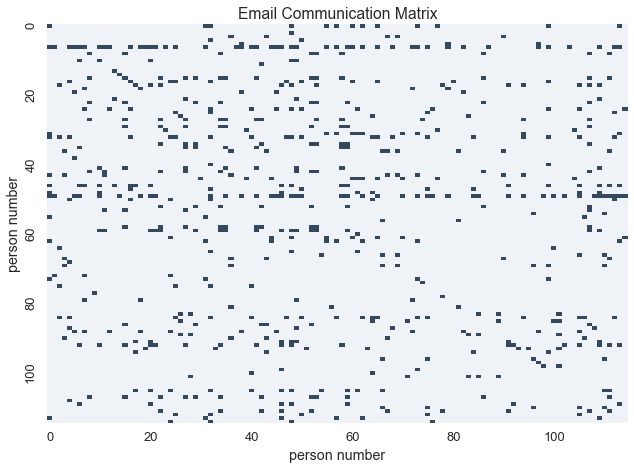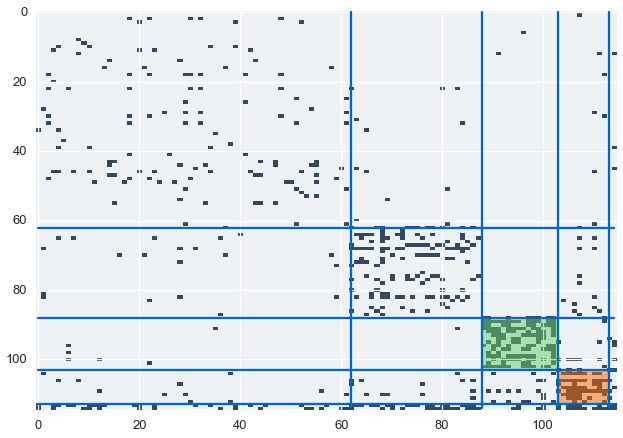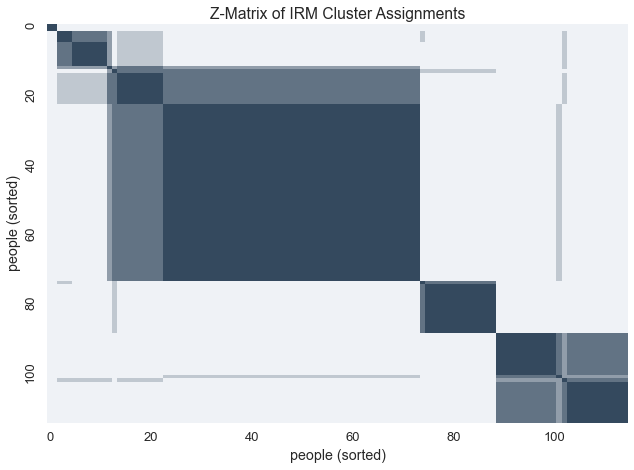Clustering the Enron e-mail corpus using the Infinite Relational Model¶
Let’s setup our environment
%matplotlib inline
import pickle
import time
import itertools as it
import numpy as np
import matplotlib.pylab as plt
import matplotlib.patches as patches
from multiprocessing import cpu_count
import seaborn as sns
sns.set_context('talk')
Below are the functions from datamicroscopes we’ll be using to cluster the data
from microscopes.common.rng import rng
from microscopes.common.relation.dataview import numpy_dataview
from microscopes.models import bb as beta_bernoulli
from microscopes.irm.definition import model_definition
from microscopes.irm import model, runner, query
from microscopes.kernels import parallel
from microscopes.common.query import groups, zmatrix_heuristic_block_ordering, zmatrix_reorder
We’ve made a set of utilities especially for this dataset,
enron_utils. We’ll include these as well.
We have downloaded the data and preprocessed it as suggested by
Ishiguro et al.
2012.
The results of the scirpt have been stored in the results.p.
enron_crawler.py in the kernels repo includes the script to create
results.p
import enron_utils
Let’s load the data and make a binary matrix to represent email communication between individuals
In this matrix, \(X_{i,j} = 1\) if and only if person\(_{i}\) sent an email to person\(_{j}\)
with open('results.p') as fp:
communications = pickle.load(fp)
def allnames(o):
for k, v in o:
yield [k] + list(v)
names = set(it.chain.from_iterable(allnames(communications)))
names = sorted(list(names))
namemap = { name : idx for idx, name in enumerate(names) }
N = len(names)
communications_relation = np.zeros((N, N), dtype=np.bool)
for sender, receivers in communications:
sender_id = namemap[sender]
for receiver in receivers:
receiver_id = namemap[receiver]
communications_relation[sender_id, receiver_id] = True
print "%d names in the corpus" % N
115 names in the corpus
Let’s visualize the communication matrix
blue_cmap = sns.light_palette("#34495e", as_cmap=True)
labels = [i if i%20 == 0 else '' for i in xrange(N)]
sns.heatmap(communications_relation, cmap=blue_cmap, linewidths=0, cbar=False, xticklabels=labels, yticklabels=labels)
plt.xlabel('person number')
plt.ylabel('person number')
plt.title('Email Communication Matrix')
<matplotlib.text.Text at 0x10aacbf10>

Now, let’s learn the underlying clusters using the Inifinite Relational Model
Let’s import the necessary functions from datamicroscopes
There are 5 steps necessary in inferring a model with datamicroscopes: 1. define the model 2. load the data 3. initialize the model 4. define the runners (MCMC chains) 5. run the runners
Let’s start by defining the model and loading the data
To define our model, we need to specify our domains and relations
Our domains are described in a list of the cardinalities of each domain
Our releations are in a list of tuples which refer to the indicies of each domain and the model type
In this case, the our domain is users, which is of size \(N\)
Our relations are users to users, both of cardinality \(N\), and we model the relation with beta-bernoulli distribution since our data is binary
defn = model_definition([N], [((0, 0), beta_bernoulli)])
views = [numpy_dataview(communications_relation)]
prng = rng()
Next, let’s initialize the model and define the runners.
These runners are our MCMC chains. We’ll use cpu_count to define our
number of chains.
nchains = cpu_count()
latents = [model.initialize(defn, views, r=prng, cluster_hps=[{'alpha':1e-3}]) for _ in xrange(nchains)]
kc = runner.default_assign_kernel_config(defn)
runners = [runner.runner(defn, views, latent, kc) for latent in latents]
r = parallel.runner(runners)
From here, we can finally run each chain of the sampler 1000 times
start = time.time()
r.run(r=prng, niters=1000)
print "inference took {} seconds".format(time.time() - start)
inference took 128.098203897 seconds
Now that we have learned our model let’s get our cluster assignments
infers = r.get_latents()
clusters = groups(infers[0].assignments(0), sort=True)
ordering = list(it.chain.from_iterable(clusters))
Let’s sort the communications matrix to highlight our inferred clusters
z = communications_relation.copy()
z = z[ordering]
z = z[:,ordering]
sizes = map(len, clusters)
boundaries = np.cumsum(sizes)[:-1]
Our model finds suspicious cluster based on the communication data. Let’s color and label these clusters in our communications matrix.
def cluster_with_name(clusters, name, payload=None):
ident = namemap[name]
for idx, cluster in enumerate(clusters):
if ident in cluster:
return idx, (cluster, payload)
raise ValueError("could not find name")
suspicious = [
cluster_with_name(clusters, "horton-s", {"color":"#66CC66", "desc":"The pipeline/regulatory group"}),
cluster_with_name(clusters, "skilling-j", {"color":"#FF6600", "desc":"The VIP/executives group"}),
]
suspicious = dict(suspicious)
for idx, (boundary, size) in enumerate(zip(boundaries, sizes)):
if size < 5:
continue
plt.plot(range(N), boundary*np.ones(N), color='#0066CC')
plt.plot(boundary*np.ones(N), range(N), color='#0066CC')
if idx in suspicious:
rect = patches.Rectangle((boundary-size, boundary-size),
width=size, height=size, alpha=0.5, fc=suspicious[idx][1]["color"])
plt.gca().add_patch(rect)
plt.imshow(z, cmap=blue_cmap, interpolation='nearest', aspect='auto')
<matplotlib.image.AxesImage at 0x10af923d0>

We’ve identified two suspicious clusters. Let’s look at the data to find out who these individuals are
def cluster_names(cluster):
return [names[idx] for idx in cluster]
def get_full_name(name):
return enron_utils.FULLNAMES.get(name, name)
def get_title(name):
return enron_utils.TITLES.get(name, "?")
for cluster, payload in suspicious.values():
cnames = cluster_names(cluster)
ctitles = map(get_title, cnames)
print payload["desc"]
for n, t in zip(cnames, ctitles):
print "\t", get_full_name(n), '\t\t"{}"'.format(t)
print
The pipeline/regulatory group
Lynn Blair "?"
Shelley Corman "Vice President Regulatory Affairs"
Lindy Donoho "Employee"
Drew Fossum "Vice President"
Tracy Geaccone "Employee"
harris-s "?"
Rod Hayslett "Vice President Also Chief Financial Officer and Treasurer"
Stanley Horton "President Enron Gas Pipeline"
Kevin Hyatt "Director Pipeline Business"
Michelle Lokay "Employee Administrative Asisstant"
Teb Lokey "Manager Regulatory Affairs"
Danny McCarty "Vice President"
mcconnell-m "?"
Darrell Schoolcraft "?"
Kimberly Watson "?"
The VIP/executives group
Rick Buy "Manager Chief Risk Management Officer"
Jeff Dasovich "Employee Government Relation Executive"
David Delainey "CEO Enron North America and Enron Enery Services"
Louise Kitchen "President Enron Online"
John Lavorato "CEO Enron America"
Richard Shapiro "Vice President Regulatory Affairs"
Jeffery Skilling "CEO"
Barry Tycholiz "Vice President"
Greg Whalley "President"
williams-j "?"
Given the uncertainty behind these latent clusters, we can visualize the variablity within these assignments with a z-matrix
Ordering the z-matrix allows us to group members of each possible cluster together
zmat = query.zmatrix(domain=0, latents=infers)
zmat = zmatrix_reorder(zmat, zmatrix_heuristic_block_ordering(zmat))
sns.heatmap(zmat, cmap=blue_cmap, cbar=False, xticklabels=labels, yticklabels=labels)
plt.xlabel('people (sorted)')
plt.ylabel('people (sorted)')
plt.title('Z-Matrix of IRM Cluster Assignments')
<matplotlib.text.Text at 0x10bc8bc50>
